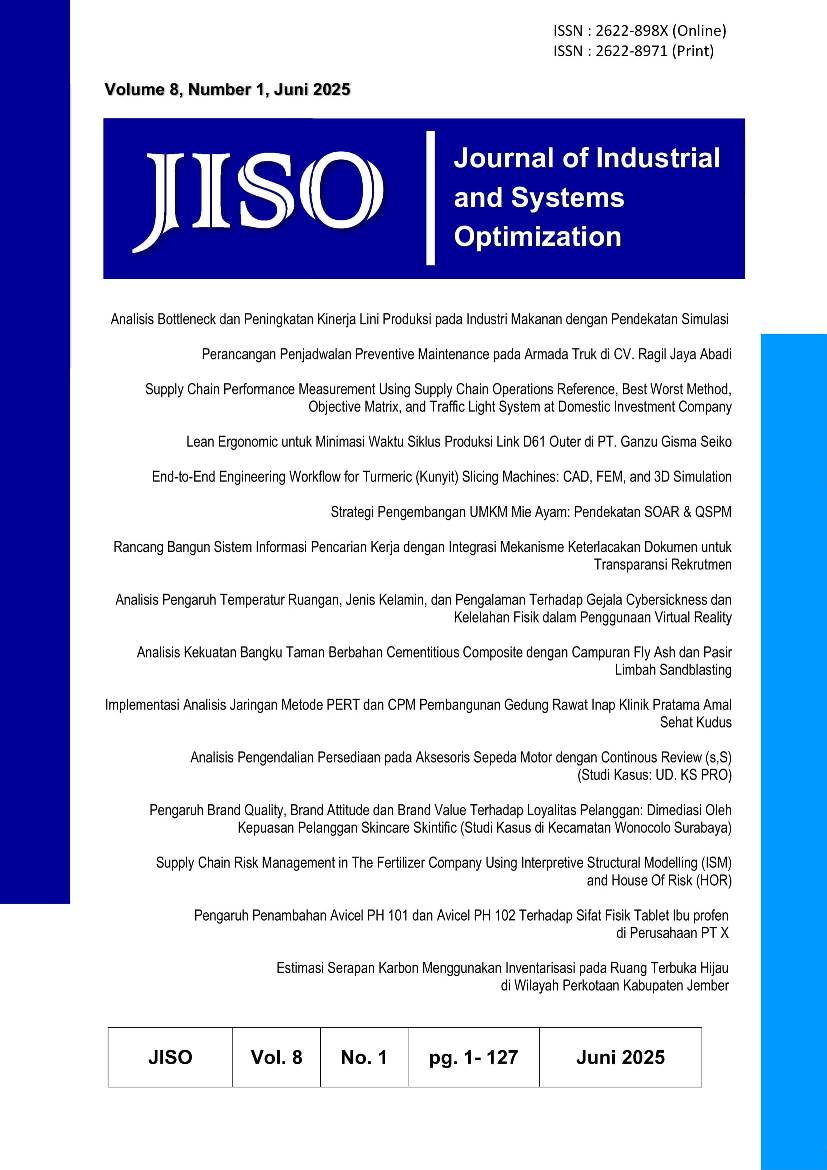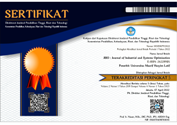ANALISIS PENGARUH TEMPERATUR RUANGAN, JENIS KELAMIN, DAN PENGALAMAN TERHADAP GEJALA CYBERSICKNESS DAN KELELAHAN FISIK DALAM PENGGUNAAN VIRTUAL REALITY
DOI:
https://doi.org/10.51804/jiso.v8i1.57-66Keywords:
Virtual Reality, Cybersickness, Kelelahan Fisik, Virtual Reality Sickness QuestionnaireAbstract
Abstrak
Salah satu teknologi yang menarik perhatian dan terus mengalami perkembangan yaitu teknologi virtual reality (VR). Namun dalam penggunaannya dapat menimbulkan gejala cybersickness dan kelelahan fisik. Faktor internal dan eksternal dapat berpengaruh terhadap munculnya gejala cybersickness dan kelelahan fisik sehingga adapun tujuan dari penelitian ini yaitu mengidentifikasi dan menganalisis pengaruh faktor internal dan eksternal berupa temperatur ruangan, jenis kelamin, dan pengalaman terhadap munculnya gejala cybersickness dan kelelahan fisik, menganalisis hubungan skor Virtual Reality Sickness Questionnaire (VRSQ) dan kelelahan fisik dan mengidentifikasi dan menganalisis beban kerja yang dirasakan pengguna, mengidentifikasi serta memberikan usulan untuk meminimasi terjadinya gejala cybersickness dan kelelahan fisik dalam menggunakan virtual reality. Adapun aktivitas yang akan dilakukan responden pada penelitian ini yaitu bermain video games beat saber selama 30 menit pada temperatur ruangan panas dan dingin. Pada penelitian ini akan digunakan alat pengukur berupa Virtual Reality Sickness Questionnaire (VRSQ) dan pengukuran denyut jantung. Adapun pengujian yang akan dilakukan pada penelitian ini yaitu pengujian Mixed ANOVA, Regresi Linear Berganda, dan Korelasi Pearson serta akan dilakukan perhitungan energi. Hasil pengujian Mixed ANOVA menunjukkan bahwa adanya pengaruh temperatur ruangan dan jenis kelamin terhadap skor Virtual Reality Sickness Questionnaire (VRSQ) dan adanya pengaruh temperatur ruangan terhadap kelelahan fisik. Hasil Regresi Linear Berganda didapatkan bahwa besar pengaruh temperatur ruangan dan jenis kelamin terhadap Virtual Reality Sickness Questionnaire (VRSQ) sebesar17,3% dan sisanya sebesar 82,7% dijelaskan oleh faktor penyebab lainnya. Skor VRSQ didapatkan bahwa 9 orang responden pada temperatur ruangan panas dan 6 orang responden pada temperatur ruangan dingin merasakan gejala cybersickness lebih dari 50% Tingkat klasifikasi beban kerja yang dirasakan oleh responden berbeda-beda serta hubungan berlawanan arah sangat lemah untuk skor VRSQ dan kelelahan fisik.
ASTRACT
One technology that attracts attention and continues to experience development is virtual reality (VR) technology. However, its use can cause symptoms of cybersickness and physical fatigue. Internal and external factors can affect the appearance of symptoms of cybersickness and physical fatigue so the objectives of this study are to identify and analyze the effect of internal and external factors in the form of room temperature, gender, and experience on the appearance of symptoms of cybersickness and physical fatigue, identify and analyze the relationship between Virtual Reality Sickness Questionnaire (VRSQ) scores and physical fatigue, identify and analyze the workload felt by users, and provide suggestions for minimizing the occurrence of symptoms of cybersickness and physical fatigue in using virtual reality. Respondents will play beat saber video games for 30 minutes at hot and cold room temperatures in this study. In this study, measuring instruments will be used in the form of the Virtual Reality Sickness Questionnaire (VRSQ) and heart rate measurements. The tests that will be carried out in this study are Mixed ANOVA testing, Multiple Linear Regression, and Pearson Correlation and energy calculations will be carried out. The results of Mixed ANOVA testing show that there is an effect of room temperature and gender on the Virtual Reality Sickness Questionnaire (VRSQ) score and the effect of room temperature on physical fatigue. The results of Multiple Linear Regression found that the effect of room temperature and gender on Virtual Reality Sickness Questionnaire (VRSQ) was 17.3% and the remaining 82.7% was explained by other causal factors. The VRSQ score found that 9 respondents at hot room temperature and 6 respondents at cold room temperature felt cybersickness symptoms of more than 50% The level of workload classification felt by respondents varies and the opposite relationship is very weak for VRSQ scores and physical fatigue
References
Clemes, S. A., & Howarth, P. A. (2005). The Menstrual Cycle and Susceptibility to Virtual Simulation Sickness. JOURNAL OF BIOLOGICAL RHYTHMS, 20(1), 71–82. https://doi.org/10.1177/0748730404272567
Djuria, S. A., Ode, L., & Rahman, A. (2021). Efektifitas Penerapan Teknologi Virtual Reality Terhadap Manajemen Nyeri Dan Ansietas Pada Pasien Kanker : Literatur Review Ansietas Kanker Nyeri Teknologi Virtual Reality. Universitas Muhamadiyah Tangerang, 6(1).
Globalwebindex. (2018). Esports Trends Report 2018. https://strivesponsorship.com/wp-content/uploads/2019/11/Esports-Trends-Report-2018.pdf
Google Trends. (2023, April). Beat Saber, Interest over time.
Haryanto, A. (2020). Revolusi Industri – Pengertian, Sejarah dan Perkembangannya. https://www.jojonomic.com/blog/pengertian-revolusi-industri/#:~:text=Revolusi industri 4.0 sudah menerapkan konsep automatisasi yang,dilakukan on time saat dibutuhkan melalui jaringan internet.
Irfan, Primasari, C. H., Sidhi, T. A. P., Wibisono, Y. P., Setyohadi, D. B., & Cininta, M. (2023). ANALISIS CYBERSICKNESS PADA PERMAINAN METAVERSE GAMELAN DEMUNG VIRTUAL REALITY. Jurnal Informatika Dan Komputer, 7(1), 126–136. https://doi.org/dx.doi.org/10.26798/jiko.v7i1.754
Iridiastadi, H., & Yassierli. (2014). Ergonomi Suatu Pengantar. In Ergonomi suatu pengantar. PT. Remaja Rosdakarya: Bandung.
Kim, H. K., Park, J., Choi, Y., & Choe, M. (2018). Virtual reality sickness questionnaire (VRSQ): Motion sickness measurement index in a virtual reality environment. Applied Ergonomics, 69, 66–73. https://doi.org/10.1016/j.apergo.2017.12.016
Kourtesis, P., Linnell, J., Amir, R., Argelaguet, F., & MacPherson, S. E. (2023). Cybersickness in Virtual Reality Questionnaire (CSQ-VR): A Validation and Comparison against SSQ and VRSQ. Virtual Worlds, 2, 16–35.
Kuswana, W. S. (2014). Ergonomi dan k3 kesehatan keselamatan kerja. Bandung: PT Remaja Rosdakarya.
Lady, L., & Wiyanto, A. S. (2019). Tingkat Kelelahan Kerja Pada Pekerja Luar Ruangan Dan Pengaruh Lingkungan Fisik Terhadap Peningkatan Kelelahan. Journal Industrial Servicess, 5(1), 58–64.
LaViola, J. (2000). A Discussion of Cybersickness in Encironments. ACM SIGCHI Bulletin, 32(1), 47–56.
Pradini, A. H., Lucitasari, D. R., & Putro, G. M. (2019). Perbaikan sistem kerja dengan pendekatan macroergonomic analysis and design (MEAD) untuk meningkatkan produktifitas pekerja (Studi kasus di UD Majid Jaya, Sarang, Rembang, Jawa Tengah). Opsi, 12(1), 36–47.
Rizzo, A., Parsons, T. D., Lange, B., Kenny, P., Buckwalter, J. G., Rothbaum, B., Difede, J., Frazier, J., Newman, B., & Williams, J. (2011). Virtual reality goes to war: A brief review of the future of military behavioral healthcare. Journal of Clinical Psychology in Medical Settings, 18, 176–187.
Rusiani, L., & Nurfajriah. (2015). Analisis Beban Kerja Fisiologi dan Psikologi Karyawan Pembuatan Baju di PT.Jaba Garmindo Majalengka. BINA TEKNIKA, 11(2), 114–123.
Sugiono, P. W. W., & Sari, S. I. K. (2018). Ergonomi untuk pemula (prinsip dasar & aplikasinya). UB Pres, Malang.
Suharyono, S., Setiya Dewi, Y., & Nur Pratiwi, I. (2021). Pengaruh Rehabilitasi Berbasis Virtual Reality dalam Menurunkan Intensitas Nyeri pada Pasien Pasca Bedah Ortopedi: Systematic Review. Jurnal Penelitian Kesehatan Suara Forikes, 12(4). https://doi.org/10.33846/sf12405
Supranto, J. (2009). Statistik: Teori dan aplikasi. Erlangga.
Susandi, D., & Wikananda, R. (2018). Analisis Beban Pada Olahraga Panahan Dengan Menggunakan Metode Fisiologi. 9th Industrial Research Workshop and National Seminar, 433–437.
Tarwaka, S., & Sudiajeng, L. (2004). Ergonomi untuk keselamatan, kesehatan kerja dan produktivitas. Surakarta: Uniba Press.
Tekno, I. A. dan. (2023). Revolusi Industri 5.0: Integrating Technology and Humanity. https://www.kompasiana.com/saikoichirou1878/6435ff4308a8b526cf090172/revolusi-industri-5-0-integrating-technology-and-humanity
Wahyuni, D., Budiman, I., Tryana Sembiring, M., Sitorus, E., & Nasution, H. (2018). The workload analysis in welding workshop. IOP Conference Series: Earth and Environmental Science, 126(1). https://doi.org/10.1088/1755-1315/126/1/012095
Wirayudi Aditama, P., Nyoman Widhi Adnyana, I., & Ayu Ariningsih, K. (2019). AUGMENTED REALITY DALAM MULTIMEDIA PEMBELAJARAN. Prosiding Seminar Nasional Desain Dan Arsitektur (SENADA), 2.
Yassierli, Pratama, G. B., Pujiartati, D. A., & Yamin, P. A. R. (2020). Ergonomi Industri (P. Latifah, Ed.).
Yildirim, G., Elban, M., & Yildirim, S. (2018). Analysis of Use of Virtual Reality Technologies in History Education: A Case Study. Asian Journal of Education and Training, 4(2), 62–69. https://doi.org/10.20448/journal.522.2018.42.62.69
Downloads
Published
Issue
Section
License
Copyright (c) 2025 JISO : Journal of Industrial and Systems Optimization

This work is licensed under a Creative Commons Attribution-ShareAlike 4.0 International License.
With the receipt of the article by JISO Editorial Board and the decision to be published, the copyright regarding the article will be transferred to JISO. The copyright transfer form can be downloaded here.
JISO has the right to multiply and distribute the article and every author is not allowed to publish the same article that was published in this journal.
JISO is licensed under a Creative Commons Attribution-ShareAlike 4.0 International License.
Under the following terms:
Attribution — You must give appropriate credit, provide a link to the license, and indicate if changes were made. You may do so in any reasonable manner, but not in any way that suggests the licensor endorses you or your use.
ShareAlike — If you remix, transform, or build upon the material, you must distribute your contributions under the same license as the original.














